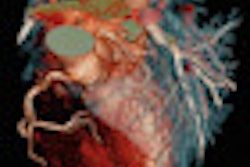Integrating PACS with the electronic health record (EHR) is no easy task, but it's worth the effort to provide clinicians with access to a single, comprehensive view of patient clinical information, according to a team from Harris County Hospital District (HCHD) in Houston.
In addition to the clinical benefits of providing clinicians with easy and patient-centered access to images and reports, a PACS-EHR integration project has led to faster turnaround for radiology reports, revenue cycle improvements, and a host of technical improvements for HCHD, the largest public primary healthcare system in Texas.
"To have common access to diagnostic results and images in a way that's easy to get to and is intuitive has really been transformative for our organization," said Dr. John Riggs, medical director of clinical information systems for HCHD.
Riggs shared HCHD's experience with integrating PACS into an EHR at the recent annual Healthcare Information and Management Systems Society meeting in Las Vegas.
HCHD is an integrated delivery system in the Houston metropolitan area comprised of three hospitals: Ben Taub General Hospital, Lyndon B. Johnson General Hospital, and Quentin Mease Community Hospital. More than 45,000 patients are admitted each year.
HCHD also includes more than 40 community private practice centers and services and supports, and supports more than 1.2 million outpatient and emergency room visits per year.
HCHD's ambulatory care services were established in 1967 and include 13 community health centers, one free-standing dental center, nine homeless shelter clinics, the Riverside Dialysis Center, and five mobile health units for an immunization and outreach program.
All HCHD facilities utilize the same EHR platform. HCHD has also extended its health record to include limited access for referring physicians who can then follow their patient's process on the EHR. Read-only access to the full electronic medical record (EMR) is provided to 10 affiliated Federally Qualified Health Centers, as well as the County Jail, Riggs said.
Image integration goals
HDHC wanted to provide a standardized, patient-specific display of information, including the original order, the report, and the images all accessible from the same location for all of its patients. They also wanted to leverage a standard interface connection for diagnostic imaging modalities.
This initiative was all made possible by an EMR design based on workflow and industry adoption of HL7 and DICOM standards, Riggs said.
Admission, discharge, and transfer order information is sent from the EMR to an interface engine, which then communicates with the appropriate imaging information systems for that order. In turn, the various imaging information systems, such as the radiology information systems (RIS), process the order and transmit it to imaging modalities (CT, ultrasound, and mammography), the gastrointestinal (GI) lab, pulmonary lab, electrocardiogram, echocardiography, and other destinations. After the images are interpreted, the interface engine relays the text results and RIS orders back to the EMR, according to Riggs.
After images are sent from the imaging modalities to the PACS, hyperlinks for the image locations on the PACS archive are sent to the interface engine, which provides them to the EMR.
To view the imaging results for a patient study, physicians open the patient record, click the imaging tab, and then click on the ordered test, Riggs said. Users can then view the results of that test and click on the hyperlinks to view the images from the PACS.
As of now, results are available in the EMR for radiology, cardiology, the GI lab, and the pulmonary lab, he said. Due to DICOM limitations, diagnostic tests, such as electromyography, electroencephalography, neurophysiology, and electrophysiology are not yet included.
Impact
Integrating imaging within the EHR has yielded a number of clinical, revenue cycle, and technical benefits. In addition to common access to both results and images, the project has contributed to faster turnaround for final reports, Riggs said.
Results and links to images can also be routed in the EHR to the ordering provider, he said.
On the revenue side, the time it takes to submit charges has been vastly reduced, he said. In addition, HCHD has found an increase in charge accuracy and completeness.
HCHD has also realized technical benefits, such as faster IT integration of new modalities, streamlined maintenance of interfaces, and reduced effort required in an RIS replacement project, he said.
Since 2006, the time to integrate new imaging modalities has been decreased from several days to 24 hours or fewer, Riggs said. In addition, integration of new reporting applications has been reduced from six months to 60 days.
"The benefit of being able to expand and modernize our diagnostic imaging systems has really been profound," he said.




















